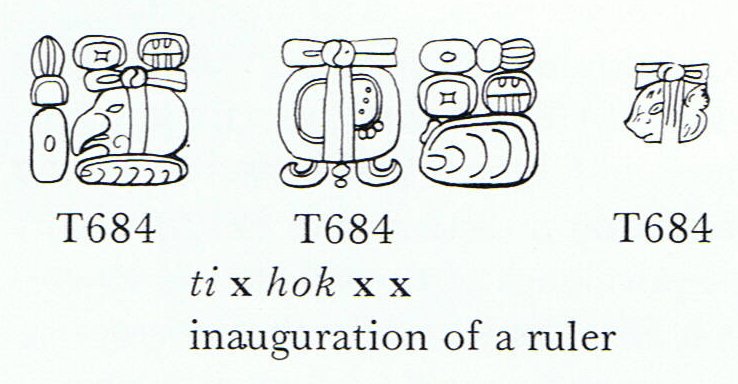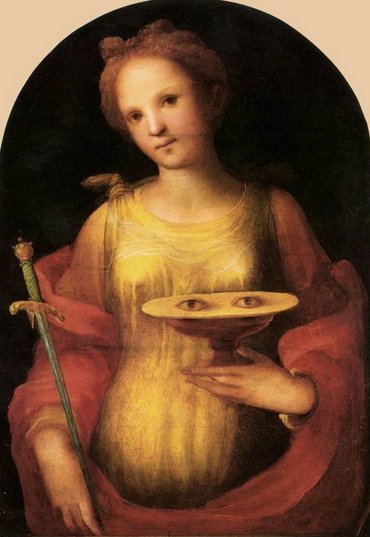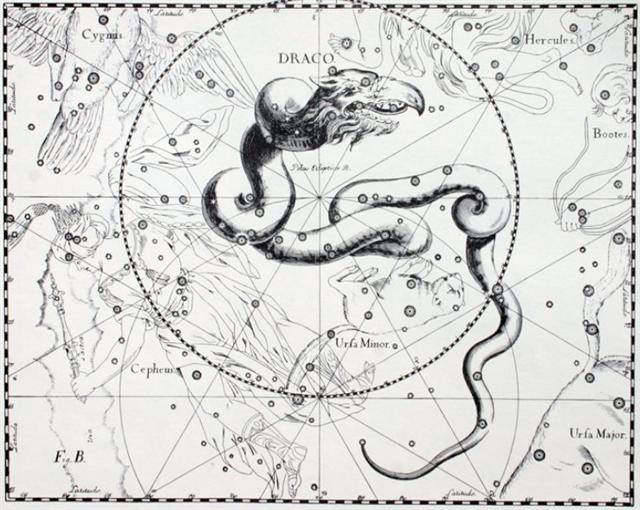Bb12-7 At the top of the world the star Etamin marked the head quarter of Draco.
... Another year passed, and a man by the name of Ure Honu went to work in his banana plantation. He went and came to the last part, to the 'head' (i.e., the upper part of the banana plantation), to the end of the banana plantation. The sun was standing just right for Ure Honu to clean out the weeds from the banana plantation. On the first day he hoed the weeds. That went on all day, and then evening came. Suddenly a rat came from the middle of the banana plantation. Ure Honu saw it and ran after it. But it disappeared and he could not catch it. On the second day of hoeing, the same thing happened with the rat. It ran away, and he could not catch it. On the third day, he reached the 'head' of the bananas and finished the work in the plantation. Again the rat ran away, and Ure Honu followed it. It ran and slipped into the hole of a stone. He poked after it, lifted up the stone, and saw that the skull was (in the hole) of the stone. (The rat was) a spirit of the skull (he kuhane o te puoko). ... In China, with Capricornus, Pisces, and a part of Sagittarius, it [Aquarius] constituted the early Serpent, or Turtle, Tien Yuen; and later was known as Hiuen Ying, the Dark Warrior and Hero, or Darkly Flourishing One, the Hiuen Wu, or Hiuen Heaou, of the Han dynasty, which Dupuis gave as Hiven Mao. It was a symbol of the emperor Tchoun Hin, in whose reign was a great deluge; but after the Jesuits came in it became Paou Ping, the Precious Vase. It contained three of the sieu, and headed the list of zodiac signs as the Rat, which in the far East was the ideograph for 'water', and still so remains in the almanacs of Central Asia, Cochin China, and Japan ...
Ure Honu was amazed and said, 'How beautiful you are! In the head of the new bananas is a skull, painted with yellow root and with a strip of barkcloth around it.'
Ure Honu stayed for a while, (then) he went away and covered the roof of his house in Vai Matā. It was a new house. He took the very large skull, which he had found at the head of the banana plantation, and hung it up in the new house. He tied it up in the framework of the roof (hahanga) and left it hanging there ...
... The Mahabharata insists on six as the number of the Pleiades as well as of the mothers of Skanda and gives a very broad and wild description of the birth and the installation of Kartikeya 'by the assembled gods ... as their generalissimo', which is shattering, somehow, driving home how little one understands as yet. The least which can be said, assuredly: Mars was 'installed' during a more or less close conjunction of all planets; in Mbh. 9.45 (p. 133) it is stressed that the powerful gods assembled 'all poured water upon Skanda, even as the gods had poured water on the head of Varuna, the lord of waters, for investing him with dominion'. And this 'investiture' took place at the beginning of the Krita Yuga, the Golden Age ...
... When the man, Ulu (→ Breadfruit),
returned to his wife from his visit to the temple at Puueo, he said, 'I have heard the voice of the noble Mo'o, and he has told me that tonight, as soon as darkness draws over the sea and the fires of the volcano goddess, Pele, light the clouds over the crater of Mount Kilauea, the black cloth will cover my head. And when the breath has gone from my body and my spirit has departed to the realms of the dead, you are to bury my head carefully near our spring of running water. Plant my heart and entrails near the door of the house. My feet, legs, and arms, hide in the same manner. Then lie down upon the couch where the two of us have reposed so often, listen carefully throughout the night, and do not go forth before the sun has reddened the morning sky. If, in the silence of the night, you should hear noises as of falling leaves and flowers, and afterward as of heavy fruit dropping to the ground, you will know that my prayer has been granted: the life of our little boy will be saved.' And having said that, Ulu fell on his face and died ... Uru. 1. To lavish food on those who have contributed to the funerary banquet (umu pâpaku) for a family member (said of the host, hoa pâpaku). 2. To remove the stones which have been heated in the umu, put meat, sweet potatoes, etc., on top of the embers, and cover it with those same stones while red-hot. 3. The wooden tongs used for handling the red-hot stones of the umu. 4. To enter into (kiroto ki or just ki), e.g. he-uru kiroto ki te hare, he-uru ki te hare. 5. To get dressed: kahu uru. Vanaga. Uruga. Prophetic vision. It is said that, not long before the first missionaries' coming a certain Rega Varevare a Te Niu saw their arrival in a vision and travelled all over the island to tell it: He-oho-mai ko Rega Varevare a Te Niu mai Poike, he mimiro i te po ka-variró te kaiga he-kî i taana uruga, he ragi: 'E-tomo te haûti i Tarakiu, e-tomo te poepoe hiku regorego, e-tomo te îka ariga koreva, e-tomo te poporo haha, e-kiu te Atua i te ragi'. I te otea o te rua raá he-tu'u-hakaou ki Poike; i te ahi mo-kirokiro he-mate. Rega Varevare, son of Te Niu, came from Poike, and toured the island proclaiming his vision: 'A wooden house will arrive at Tarakiu (near Vaihú), a barge will arrive, animals will arrive with the faces of eels (i.e. horses), golden thistles will come, and the Lord will be heard in heaven'. The next morning he arrived back in Poike, and in the evening when it was getting dark, he died. Vanaga. He ui a Ira.ko te motu etoru.he ki a Ira.he ro korua e kau a repa e ku ketu ana te urunga.a Hau maka o to tatou matua.i hakahi mai ai kia au.ko nga kope ririva tutuu vai a te taanga.te ingoa o te motu ena etoru i nape ai e te kuhane o Hau maka. Ira saw that there were three such islets. Ira said, 'Hey you, crew of young men, the vision of Hau Maka, our father, which he revealed to me, has come true. There are 'the handsome sons of Te Taanga, who are standing in the water', for this is the name that the dream soul of Hau Maka gave them. [E:17] Uru manu. Those who do not belong to the Miru tribe and who, for that reason, are held in lesser esteem. Úru-úru. To catch small fish to use as bait. Uru-uru-hoa. Intruder, freeloader (person who enters someone else's house and eats food reserved for another). Vanaga. 1. To enter, to penetrate, to thread, to come into port (huru); uru noa, to enter deep. Hakauru, to thread, to inclose, to admit, to drive in, to graft, to introduce, penetrate, to vaccinate, to recruit. Akauru, to calk. Hakahuru, to set a tenon into the mortise, to dowel. Hakauruuru, to interlace; hakauruuru mai te vae, to hurry to. 2. To clothe, to dress, to put on shoes, a crown. Hakauru, to put on shoes, to crown, to bend sails, a ring. 3. Festival, to feast. 4. To spread out the stones of an oven. Uruuru, to expand a green basket. 5. Manu uru, kite. Uruga (uru 1). Entrance. Churchill. Ta.: uru, the human skull. Mq.: uu, the head. Sa.: ulu, id. Moriori: ulu, id. Uru, make even. Kapingamarangi. The Head of Ulu had to be buried close to running spring water. Evidently this should in ancient Egypt correspond to the Delta (Δ) of the Nile:
... The myth goes on to tell of the blessed boat's arrival in the marshes of the Delta, and of how Set, one night hunting the boar by the light of the full moon, discovered the sarcophagus and tore the body into fourteen pieces, which he scattered abroad; so that, once again, the goddess had a difficult task before her. She was assisted, this time, however, by her little son Horus, who had the head of a hawk, by the son of her sister Nephtys, little Anubis, who had the head of a jackal, and by Nephtys herself, the sister-bride of their wicked brother Set. Anubis, the elder of the two boys, had been conceived one very dark night, we are told, when Osiris mistook Nephtys for Isis; so that by some it is argued that the malice of Set must have been inspired not by the public virtue and good name of the noble culture hero, but by this domestic inadventure. The younger, but true son, Horus, on the other hand, had been more fortunately conceived - according to some, when Isis lay upon her dead brother in the boat, or, according to others, as she fluttered about the palace pillar in the form of a bird. The four bereaved and searching divinities, the two mothers and their two sons, were joined by a fifth, the moon-god Thoth (who appears sometimes in the form of an ibis-headed scribe, at other times in the form of a baboon), and together they found all of Osiris save his genital member, which had been swallowed by a fish ...
However, in ancient Egypt everything was upside down with the source of the Nile far up in the south and its final down in the north. The top of the world was in the south, and from there the flowing sweet waters of the Nile ran down all the way to the Delta. Therefore what was engulfed by a Fish was not a Head (high up) but a Penis (low down below the belt). Thus, down on Easter Island they associated the head of the King with the same power of re-creation as a genital member. ... Up to the present time, fertility spells for fowls have played an important role. Especially effective were the so-called 'chicken skulls' (puoko moa) - that is, the skulls of dead chiefs, often marked by incisions, that were considered a source of mana. Their task is explained as follows: 'The skulls of the chiefs are for the chicken, so that thousands may be born' (te puoko ariki mo te moa, mo topa o te piere) ... As long as the source of mana is kept in the house, the hens are impregnated (he rei te moa i te uha), they lay eggs (he ne'ine'i te uha i te mamari), and the chicks are hatched (he topa te maanga). After a period of time, the beneficial skull has to be removed, because otherwise the hens become exhausted from laying eggs ... After the assassination of Captain Cook they were able to retrieve his dead body - with the exception of his head and his hands. This probably meant not only the Head but also Hands were necessary for re-creation.
... Nevertheless, by virtue of a series of spectacular coincidences, Cook made a near-perfect ritual exit on the night of 3 February. The timing itself was nearly perfect, since the Makahiki rituals would end 1 February (±1 day), being the 14th day of the second Hawaiian month [Kau-lua]. This helps explain Mr. King's entry for 2 February in the published Voyage: 'Terreoboo [Kalaniopu'u] and his Chiefs, had, for some days past, been very inquisitive abouth the time of our departure' - to which his private journal adds, '& seem'd well pleas'd that it was soon'. Captain Cook, responding to Hawaiian importunities to leave behind his 'son', Mr. King [sic!], had even assured Kalaniopu'u and the high priest that he would come back again the following year. Long after they had killed him, the Hawaiians continued to believe this would happen. With the high priest's permission, the British just before leaving removed the fence and certain images of Hikiau temple for firewood. Debate raged in the nineteenth century about the role of this purported 'sacriledge' in Cook's death, without notice, however, that following Lono's sojourn the temple is normally cleared and rebuilt - indeed, the night the British left one of the temple houses was set on fire. Among the other ritual coincidences, perhaps the most remarkable was the death of poor old Willie Watman, seaman A. B., on the morning of 1 February. Watman was the first person among Cook's people to die at Kealakekua: on the ceremonial day, so far as can be calculated, that the King's living god Kahoali'i would swallow the eye of the first human sacrifice of the New Year. And it was the Hawaiian chief - or by one account, the King himself - who specifically requested that old Watman be buried at Hikiau temple. Messrs. Cook and King read the burial service, thus introducing Christianity to the Sandwich Islands, with the assistance however of the high priest Ka'oo'oo and the Lono 'brethren', who when the English had finished proceeded to make sacrifices and perform ceremonies at the grave for three days and nights. So in the early hours of 4 February, Cook sailed out of Kealakekua Bay, still alive and well. The King, too, had survived Lono's visit and incorporated its tangible benefits, such as iron adzes and daggers. In principle, the King would now make sacrifices to Kuu and reopen the agricultural shrines of Lono. The normal cosmic course would be resumed ... ... Cook's first visit, to Kaua'i Island in January 1778, fell within the traditional months of the New Year rite (Makahiki). He returned to the Islands late in the same year, very near the recommencement of the Makahiki ceremonies. Arriving now off northern Maui, Cook proceeded to make a grand circumnavigation of Hawai'i Island in the prescribed clockwise direction of Lono's yearly procession, to land at the temple in Kealakekua Bay where Lono begins and ends his own circuit. The British captain took his leave in early February 1779, almost precisely on the day the Makahiki ceremonies closed. But on his way out to Kahiki, the Resolution sprung a mast, and Cook committed the ritual fault of returning unexpectedly and unintelligibly. The Great Navigator was now hors catégorie, a dangerous condition as Leach and Douglas have taught us, and within a few days he was really dead - though certain priests of Lono did afterward ask when he would come back ...
... Then Hotu said to Teke, 'There shall be an equal number of people (i.e., of both sexes) when you take them aboard the canoe. The same (goes) for the four-legged animals, the pigs (?) and the chicken.' Teke went with all his assistants. They took the four-legged animals, male and female, fifty in all. [25 + 25 = 50] (There were) fifty four-legged animals. [50 * 4 = 200] They took all kinds of birds [anake te huru o te manu], male and female, a hundred pigs (?), [50 + 50 = 100] 500 chickens, [250 + 250 = 500] and five large calabashes (kaha) full of flies ... [E:71 → 26000 / 366]
The source of the running water was evidently that part of the Milky Way (the Nile) which looked like the open jaws (vaha mea) of a crocodile (cayman, keyemen) or a shark,
or like a robber's stick (or uru, the wooden tongs used for handling the red-hot stones in the umu): ... The ancestor slipped into the workshop of the great Nummo, who are Heaven's smiths, and stole a piece of the sun in the form of live embers and white-hot iron. He seized it by means of a 'robber's stick' the crook of which ended in a slit, open like a mouth ...
... Macrobius, who has provided the broadest report on the matter, has it that souls ascend by way of Capricorn, and then, in order to be reborn, descend again through the 'Gate of Cancer'. Macrobius talks of signs; the constellations rising at the solstices in his time (and still in ours) were Gemini and Sagittarius: the 'Gate of Cancer' means Gemini ... Viz. the configuration of the Southern Dipper, where the Green Serpent had its Head:
Indeed, we can now identify the source in our fundamental number table - it was the Fortnight (the year should not be counted in weeks because 7 is an odd number).
...Then the big Fish did swallow him, and he had done acts worthy of blame. Had it not been that he (repented and) glorified Allah, He would certainly have remained inside the Fish till the Day of Resurrection. - Qur'an, chapter 37 (As-Saaffat), verse 139–144. But We cast him forth on the naked shore in a state of sickness, And We caused to grow, over him, a spreading plant of the gourd kind. And We sent him (on a mission) to a hundred thousand (men) or more. And they believed; so We permitted them to enjoy (their life) for a while. - Qur'an, chapter 37 (As-Saaffat), verse 145–148 ...
Fom-al-haut (the Mouth of the Fish) culminated (at 21h) in October 25, when April 25 had been at the Full Moon, and here the Explorers had left Easter Island in order to go home.
|
|||||||||||||||||||||||||||||||||||||||||||||||||||||||||||||||||||||||||||||||||||||||||||||||||||||||||||||||||||||||||














.jpg)

.jpg)








